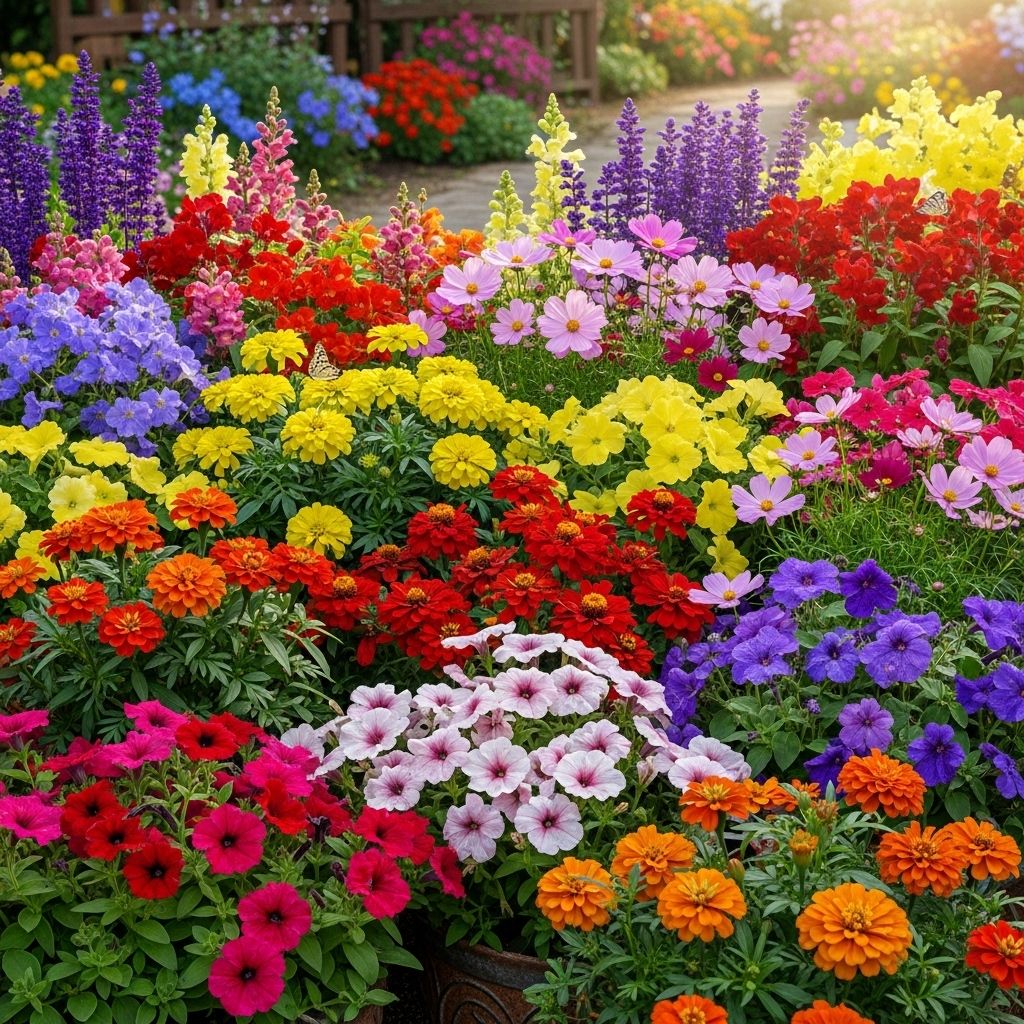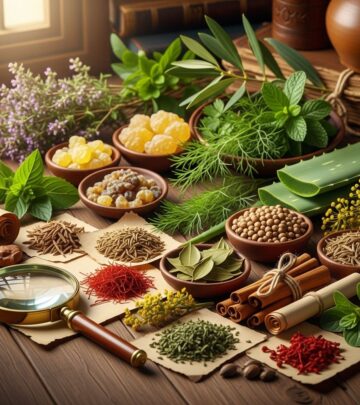18 Best Annual Flowers to Transform Your Garden: Expert Picks for Color and Resilience
Curated blooms that ensure nonstop seasonal color with minimal maintenance.

18 Annual Flowers to Brighten Your Garden: Expert Recommendations
If you’re hoping to inject bold, lasting color into your garden beds, borders, or containers, annual flowers are the answer. Unlike perennials, which return year after year, annuals complete their life cycle in one season, offering gardeners the exciting opportunity to experiment and refresh their plantings annually. Based on expert advice from horticulturists and garden professionals, we’ve curated a list of standout annuals that combine vibrant display, easy maintenance, and resilience to a variety of conditions.
How to Choose Annual Flowers for Your Garden
Selecting the right annual flowers depends on factors such as your local climate, soil type, and growing conditions. Consider the following when shopping for annuals:
- Cold Hardiness: Annuals are classified as tender, hardy, or half-hardy. Tender annuals thrive in heat but won’t survive frost, while hardy types withstand cooler temperatures.
- Sun Exposure: Study the light requirements; some annuals flourish in full sun, while others prefer partial shade.
- Maintenance: Check if the flower needs regular deadheading (removing spent blooms) or trims to keep looking its best.
- Deer and Pest Resistance: Certain annuals resist browsing and common garden pests, making them ideal for wildlife-prone areas.
Consult your local nursery or gardening professionals for recommendations tailored to your region, and always match plant choices to your USDA hardiness zone.
Expert Picks: The Best Annual Flowers
Below, you’ll find 18 highly recommended annual flowers, each offering unique beauty and benefits to your garden:
Begonias
Begonias are universally celebrated as the workhorse of summer shade gardens. Renowned for their adaptability, they come in a wide array of shapes, sizes, and colors, making them suitable for both shady beds and brighter areas. Certain varieties, like ‘Big Begonia’, can thrive even in sunny locations and have been prominently featured in public landscapes such as the White House lawn.
- Blooms from spring through frost
- Perfect for hanging baskets, containers, and borders
- Available in pink, white, red, and bi-colored varieties
Zinnias
Zinnias are a butterfly magnet, with vibrant blooms in reds, yellows, oranges, and more. Fast-growing from seed, they’re an ideal choice for direct sowing after the last spring frost. Tall zinnias are excellent for the back of beds, while shorter varieties are suitable for front borders and containers.
- Full sun lovers
- Easy to grow from seed
- Available in a wide spectrum of bright colors
Petunias
Looking for continuous color and trailing blooms? Petunias feature vivid flowers in a wide range of colors and patterns. Their trailing habit makes them a staple for hanging baskets and window boxes, ensuring nonstop blooms from spring to frost with little maintenance.
- Ideal for containers and landscapes
- Available in solid, patterned, and ruffled varieties
- Deadheading encourages prolonged blooming
Poppies
Delicate yet surprisingly tough, poppies such as the California poppy tolerate drought and thrive in poor soils. Their striking colors are perfect for terraces, borders, and container displays, adding a cheerful touch that withstands urban and rural conditions alike.
- Drought-tolerant
- Available in orange, red, yellow, pink, and white
- Easy to direct sow
Vincas
Sometimes called periwinkle, vincas breathe life into full sun gardens with hues from pink and purple to pristine white. Renowned for their resistance to frost, shade, and deer, vincas bloom all summer, providing reliable color throughout the season.
- Full sun required
- Resistant to deer and mild frosts
- Sweet-smelling flowers
Morning Glories
Morning glories deliver a stunning pop of blue and are coveted for their vining nature, making them excellent for trellises and fences. Their scent draws beneficial pollinators and their fast-growing habits ensure quick cover and color.
- Vining habit suits vertical spaces
- Attracts pollinators
- Available in blues, purples, pinks, and more
Cosmos
Cosmos are beloved for their long season and dainty, daisy-like flowers that bloom from summer into fall. Their gentle sway and delicate petal structure add an airy quality to borders, and they are highly attractive to bees and butterflies.
- Easy to grow from seed
- Blooms in pink, white, and magenta
- Tolerates poor soils
Dahlias
Dahlias, arising from tubers, offer a kaleidoscope of colors, shapes, and sizes. Though tender to cold, when planted after the last frost, they flower spectacularly through autumn. Their dramatic blooms are a favorite for cut flower arrangements and garden focal points.
- Planted from tubers after frost
- Flowers range from puckered balls to dinner-plate blooms
- Wide color palette available
Marigolds
With their cheery yellows, oranges, and creams, marigolds are drought-tolerant and thrive in poor soils and full sun. They’re valued for pest-repelling properties and are often planted alongside vegetables for companion benefit.
- Hardy and resilient
- Bloom from late spring into frost
- Height ranges from 6 to 18 inches
Sweet Alyssum
This low-growing plant forms fragrant mats of pink, purple, or white blooms. Sweet Alyssum is excellent for cascading over containers and basket edges and thrives in cooler conditions, even tolerating light frosts.
- Attracts pollinators
- Grows in part sun to full sun
- Perfect for edging and container planting
Angelonia (Summer Snapdragon)
Celebrated for spike-like blooms in colors ranging from purple to peach and yellow, angelonia flourishes in summer heat unlike true snapdragons. It features upright or cascading forms, bringing longevity to hot-season flower beds.
- Thrives in full sun
- Drought-tolerant
- Blooms from midsummer to frost
Cuphea
Often called firecracker or cigar plant, cuphea displays bright orange, tubular flowers that hummingbirds can’t resist. Heat-tolerant and vigorous, it’s best planted where it won’t crowd out slower neighbors.
- Prefers full sun
- Attracts pollinators, especially hummingbirds
- Best grown in containers to manage vigorous spreading
Lobelia
Lobelia’s delicate blue, purple, or white flowers spill gracefully from hanging baskets and window boxes. Sensitive to heat, it may need trimming back to revive in fall after a summer lull.
- Prefers cool conditions with part sun to full shade
- Ideal for containers and shady garden niches
- May require rejuvenation during hot spells
Calibrachoa
Resembling miniature petunias, Calibrachoa’s trumpet-shaped flowers blanket planters and baskets with color. It blooms prolifically without deadheading, offering vibrant shades spanning the rainbow.
- Requires part sun to full sun
- Low maintenance
- Beloved by hummingbirds
Torenia
Known for its tubular blossoms in pink, purple, or white, Torenia attracts hummingbirds and looks stunning tumbling from window boxes and containers. It thrives in shaded environments, making it an excellent choice for low-light spots.
- Grows in full shade to part shade
- Tubular flowers support pollinators
- Ideal for window boxes
Sunflowers
Sunflowers add vertical drama and brilliant yellow hues to vegetable patches and flower beds alike. Their large heads attract pollinators and birds with seeds, and varieties range from classic tall types to compact cultivars for smaller spaces.
- Excellent bee and butterfly attractor
- Fast and easy to grow from seed
- Great for cutting, borders, or backdrops
Snapdragons
Often grown as cool-season annuals, snapdragons produce spikes of vibrant flowers in almost every color and are loved for their whimsical ‘snapping’ jaws. They thrive early in the season and may rebloom with proper care.
- Prefer cool spring and fall temperatures
- Various heights for bedding or container use
- Available in solid and mixed colors
Pansies and Violas
Remarkably frost-resistant, pansies and violas are perfect cool-season fillers. Their friendly faces and multitude of color combinations make them a favorite for autumn and early-spring gardens.
- Best for shoulder seasons
- Tolerant of light frosts
- Compact and spreading growth
Why Plant Annual Flowers?
Annuals offer more than temporary beauty. Benefits include:
- Flexibility: Try new colors and textures each year, or refresh garden plans seasonally.
- Continuous Color: Many annuals provide nonstop blooms, filling gaps while perennials mature.
- Wildlife Boost: Attract pollinators, butterflies, and birds.
- Companion Planting: Some annuals repel pests or attract beneficial insects, improving overall garden health.
Note that what qualifies as an ‘annual’ may vary based on your USDA zone. Many popular choices originate from tropical regions and require replanting each year outside warmer climates.
Meet the Experts
This guide synthesizes recommendations from experienced professionals:
- Dan Stuppiello – Divisional Merchandise Manager of Live Goods, Home Depot
- Rebecca Sears – Chief Marketing Officer & Resident Green Thumb, Ferry-Morse
Both stress the importance of matching flower choice to your zone and microclimate, and regularly experimenting for best results.
Tips for Success With Annuals
To maximize the impact and longevity of your annual flower displays, consider the following:
- Planting Time: Sow seeds or transplant after your region’s final spring frost.
- Fertilization: Use extended-release or liquid fertilizer to encourage continued blooming, especially in containers where nutrients leach quickly.
- Deadheading: Remove spent blooms regularly for continued flowering.
- Watering: Most annuals prefer evenly moist soil; adjust care to suit drought-tolerant varieties.
- Design: Mix annuals with perennials for an evolving, diverse garden structure.
Frequently Asked Questions (FAQs)
Q: What is the difference between annuals and perennials?
A: Annuals complete their life cycle in one growing season and must be replanted each year. Perennials persist for multiple years, returning season after season.
Q: When should I plant annual flowers?
A: Most annuals are best planted after the last local spring frost. Consult your regional USDA Hardiness Zone and specific flower requirements for exact timing.
Q: Do annual flowers require fertilizer?
A: Yes. For robust growth and bloom, use a granular extended-release fertilizer or a liquid fertilizer with each watering, especially for container-grown plants.
Q: Can I grow annuals in containers?
A: Absolutely. Many annuals are ideal for pots, window boxes, and hanging baskets. Ensure containers have drainage and use premium potting mix for best results.
Q: Which annuals are best for attracting pollinators?
A: Zinnias, sunflowers, cosmos, cuphea, calibrachoa, and sweet alyssum are proven favorites for butterflies, bees, and hummingbirds.
Annual Flower Comparison Table
| Flower | Preferred Light | Drought Tolerance | Main Colors | Notable Features |
|---|---|---|---|---|
| Begonias | Shade/Part Sun | Moderate | Red, Pink, White | Versatile, shade-tolerant |
| Zinnias | Full Sun | High | Red, Yellow, Orange, Pink | Attracts butterflies, easy from seed |
| Petunias | Full Sun | Moderate | Multiple colors | Trailing habit, long blooming |
| Poppies | Full Sun | High | Orange, Red, Yellow, White | Drought-tolerant, pop of color |
| Vincas | Full Sun | High | Pink, Purple, White | Deer and frost-resistant |
| Sunflowers | Full Sun | High | Yellow | Height, attracts pollinators |
| Sweet Alyssum | Part to Full Sun | Moderate | White, Pink, Purple | Fragrant, cascades beautifully |
| Dahlias | Full Sun | Moderate | All colors | Large, striking blooms |
Conclusion
Choosing the best annual flowers for your garden means considering your climate, garden space, and color tastes—then selecting from among expert favorites like begonias, zinnias, petunias, and more. Experiment freely, pair annuals with perennials, and enjoy a garden that surprises you anew every year.
References
- https://www.prevention.com/life/g44345913/best-annual-flowers/
- https://www.thepioneerwoman.com/home-lifestyle/gardening/g43431396/annual-flowers/
- https://www.gardenary.com/blog/best-flowers-to-grow-in-vegetable-garden
- https://www.provenwinners.com/learn/top-ten-lists/10-best-annual-flowers-are-easy-grow
- https://growinginthegarden.com/arizona-annual-flowers-visual-guide/
- https://www.youtube.com/watch?v=W_OBSiKQvLo
- https://www.prevention.com/life/g41443015/fall-flowers/
- https://www.preen.com/learn/lawn-garden-tips/plants-trees-shrubs/annuals/seven-of-the-best-new-annual-flowers-of-2025/
Read full bio of Sneha Tete











